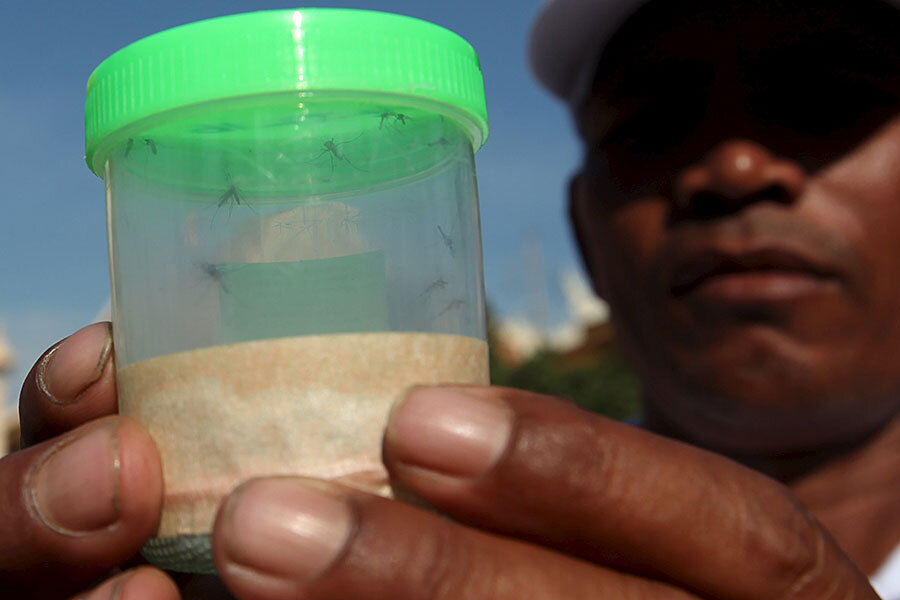Research suggests more fear than fact behind Zika threat
Loading...
The Zika virus has been portrayed as a global public health emergency. And it may be.
But a little-cited report in the scientific journal Nature, first published Jan. 28, suggests the situation may not be as dire as the headlines suggest.
Researchers at the Latin American body responsible for monitoring birth defects question the reported surge in Brazil's rate of baby abnormalities attributed to the mosquito-borne virus.
The authors, Jorge Lopez-Camelo and Ieda Maria Orioli from the Latin American Collaborative Study of Congenital Malformations (ECLAMC), propose that the apparent spike in diagnoses could be the result of an intensified search, and of misdiagnoses caused by the condition’s newfound notoriety.
They talk of a well known "awareness" effect, that may have revealed cases of the birth defect that would normally have remained undetected. Moreover, because the diagnostic criteria being used are so broad, the authors say the number of misdiagnoses is likely high.
"When people become more aware, more worried, there are lots more cases reported. This is not something new," says Luis Cuevas, professor of International Public Health and Epidemiology at the Liverpool School of Tropical Medicine in the United Kingdom, in a telephone interview with The Christian Science Monitor.
"We just don't know whether there are many more cases because there were lots not being reported, or because there actually are more cases occurring."
Other researchers have concurred that the reported increase in cases of the abnormality is probably inflated, writes Declan Butler in Nature.
But agreement with the conclusions of the ECLAMC report is not universal. A tropical medicine specialist at Heidelberg University Hospital in Germany calls the authors’ stance “extreme” and worries about the uncertainty it could create.
However, the latest figures released by the Brazilian government seem to support the study’s hypothesis. Of 4,180 cases so far reported, 270 have been confirmed and 462 rejected.
And only six cases have been shown to relate to Zika, according to Brazil's health ministry.
Dr. Cuevas explains all these "false positives" by pointing out that the initial criteria used by the ministry to direct doctors to report a suspected case are intentionally broad. This will sweep up any possible instances of the birth defect in question, allowing subsequent, more detailed testing to be carried out.
To use the more sensitive tests at the outset would be prohibitively expensive. So it is that, "at the moment, we have data that is incomplete and of poor quality," says Cuevas.
"So media and other organizations can only hypothesize."
Global Post, one of the few news outlets to highlight the study in Nature, reports that some media organizations have taken the figure of 4,000 cases of fetal abnormality and described it as the number of actual cases, as opposed to suspected or reported cases.
Indeed, in the latest press release from the World Health Organization (WHO), the wording clearly states that no definitive link between Zika and these birth defects has even been established.
“A causal relationship between Zika virus infection and birth defects and neurological syndromes has not been established, but is strongly suspected.”
The US Centers for Disease Control and Prevention (CDC) website simply states: "We do not know the risk to an infant if a woman is infected with Zika virus while she is pregnant."
There is another aspect to be considered, too: The response by organizations such as the WHO and the CDC, entrusted with the task of monitoring risks to the health of the world’s population.
The WHO, in particular, was criticized for its slow response to the 2014 Ebola crisis in West Africa, declining to declare an emergency until almost 1,000 people had died.
Understandably, the organization has been eager to show more responsiveness in the face of a potential new threat.
In addition, as the Monitor reported after the Ebola outbreak, estimates by WHO and CDC of projected cases varied wildly, from 151,000 to 4 million.
Ultimately some 11,300 people diagnosed with Ebola died.
But such forecasts have a political and financial context, too: they impact the success and funding of health agencies and programs. There is, as the Monitor reported, “an incentive to aim high."
Indeed, CDC Director Tom Frieden stated that high projection rates are designed to catch the world’s attention and urge greater action.
“Part of the point of having a projection of what might happen if we don't take urgent action is to make sure that it doesn't happen. And that's what we hope and anticipate this will result in.”
But it is not just these international organizations, and the media, that have been so quick to talk of Zika's deadly potential. Latin American governments, too, have taken action, not least in advising women to avoid getting pregnant, as the Monitor reported Wednesday:
"In Colombia, the Minister of Health and Social Protection has advised couples not to conceive until July 2016. In El Salvador, officials say to wait until 2018, advice that some see as evidence that governments are taking the virus seriously, but others consider a futile warning, tantamount to surrender."
Right now, there are many things we simply do not understand, as Cuevas tells the Monitor.
"This study [in Nature] is not denying there may be a problem, only that the link is tenuous. We need to keep an open mind."








